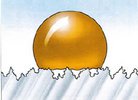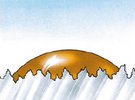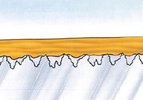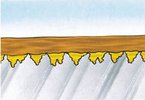Glue comes in countless guises. And common to all glue variants – ranging from child-friendly glue sticks to powerful 2-component epoxy glues – is their ability to hold two surfaces together. Dive into the universe of glue and learn more about what gives glue its many properties.

When you glue, you make use of the surface structure of the materials. Not just the one that you can see with the naked eye, but the structure that appears when you use the very large magnifying glass. Here, even smooth surfaces come to appear as mountain landscapes. It is in this structure that the gluing gets its footing. The strength of an adhesive arises from a combination of a chemical bond and physical anchoring.

Chemical bonding
In order for a chemical bond to occur between two materials, they must necessarily come very close to each other. This is because no chemical force reaches more than 5 angstroms (=0.0000005 mm). Two solid substances cannot come so close to each other, as even the smoothest materials have a profile depth, which is many times greater than this. Therefore, a material is necessary, which can fill this gap and create density, so that the chemical bond can occur – and it can glue.
Glue is liquid and can therefore be shaped according to the surface structure of the solid materials. As soon as the glue hardens, a seal is created between the materials and the glue. The optimal tightness is achieved when the material and the glue “can tolerate each other”. In other words, one can speak of a form of “chemical love” arising between the material and the glue, which implies that the glue, popularly speaking, moistens the surface. And if that is not the case, then the same situation arises as you experience when you have a drop of water on a Teflon-coated frying pan: The water drop rolls over the surface and does not wet the coating.

But if the microstructure is filled with dirt, water or (worse still) ice, it can prevent the glue from making contact, and the glue can therefore not wet the surface. Therefore, if possible, sanding the surface is also often preferable, as it removes dirt and increases the structure of the material. In addition, it is important to remember that the larger the surface, where contact can be made, the more bonds you can make, and the greater strength you achieve.
Why use a primer?
The structure of the surface also allows the glue to penetrate the material and anchor itself. This makes good sense in connection with gluing porous materials such as e.g. paper, where the glue hardens around the fibers. An important general rule is that the better the glue penetrates the material, the better anchoring is achieved there.

If you use either a very fast-setting or viscous glue, the glue may not be able to penetrate the substrate and create good contact and anchoring. Air spaces between glue and material not only result in poor adhesion. It also creates the possibility that water can penetrate between the glue and the material and cause corrosion or frost cracks, which can reduce the lifetime of the bonding.

If you first prime the surface with a thin-flowing primer, which can penetrate the surface structure, you will achieve a much smoother and filled-in structure and thus a more dense and even surface, which will allow for good adhesion of the viscous glue. This results in a long-lasting and strong bond.
Why so many types of glue?
Glue must be adapted to the material it will penetrate. There are many different materials, all of which have a very different surface structure. The glue must be adapted so that it penetrates the material, but does not disappear completely. By choosing the right glue, you achieve the best durability.
Good bonding is achieved when the glue penetrates the material and creates good contact and solid anchoring – and here the choice of glue type is crucial. At Dana Lim, we have developed our glues so that they are always adapted to the exact material for which they are intended.
Did you know that:
Glue is by no means a modern invention? As early as 200,000 years ago, hunters of the past used tar from birch tree bark to mount pointed stones on wooden sticks to make spears. Likewise, other natural products, including everything from egg whites, fish skins and plant rubber to boiled horse teeth and bison hooves, have been used as glue throughout history. It was not until 1750 that the world’s first glue factory was established.
Already in the interwar period, Dana Lim launched the small yellow tube of solvent-containing cellulose glue. It quickly became popular as a hobby glue – even long before concepts such as hobby and domestic leisure activities had gained traction in Denmark.

If you have further questions, you can contact our Technical Service.

